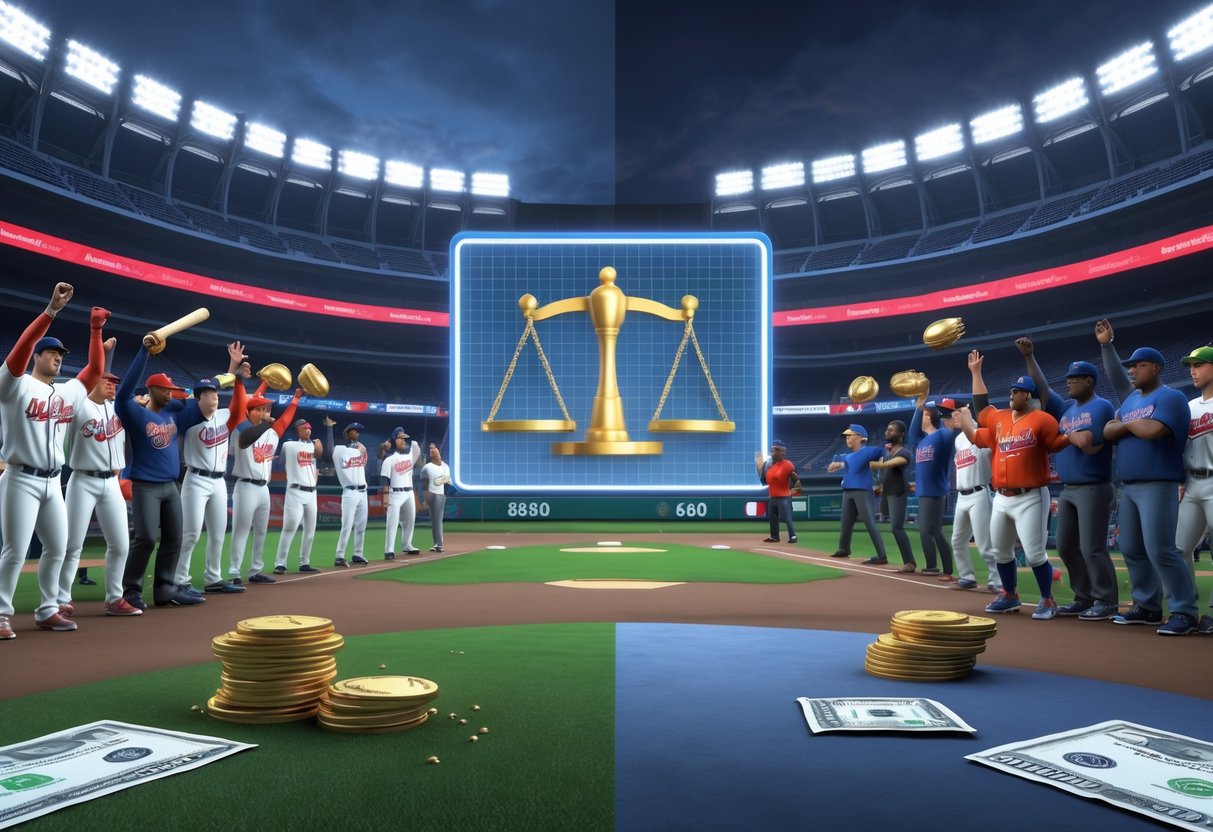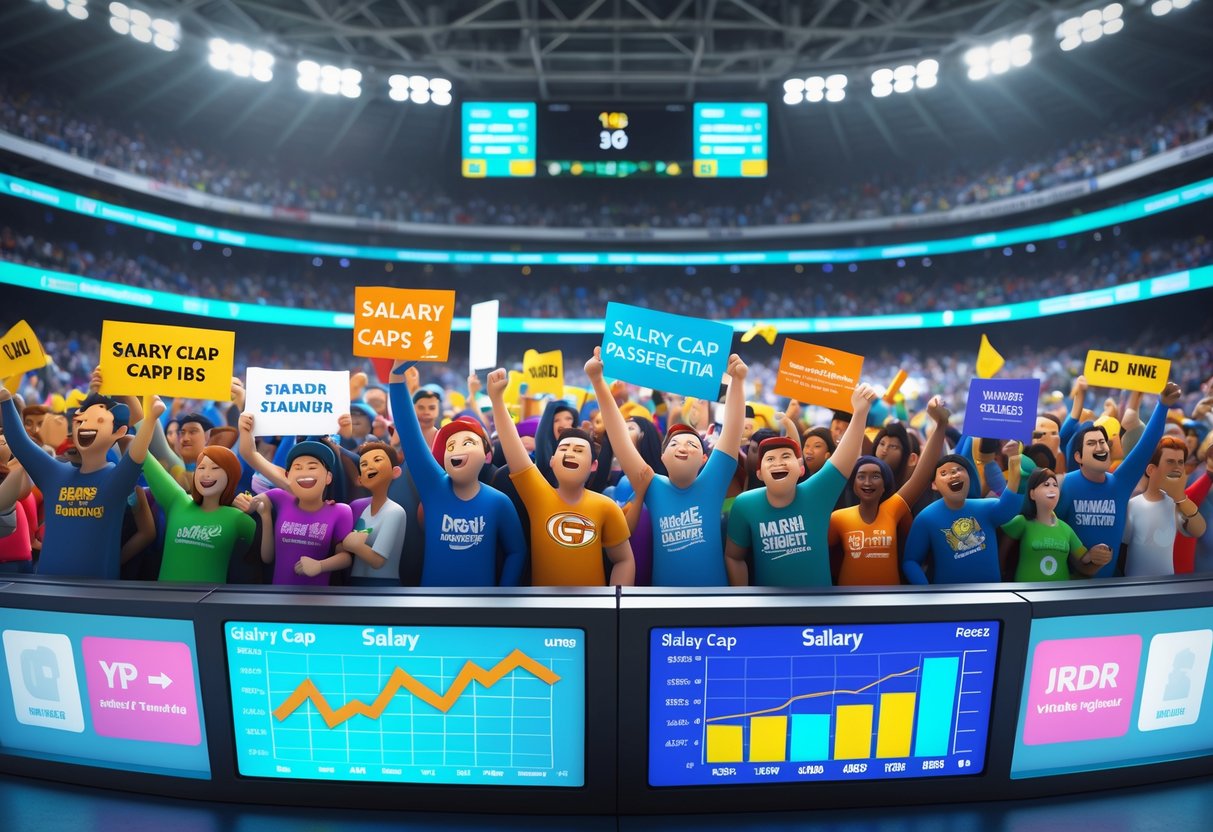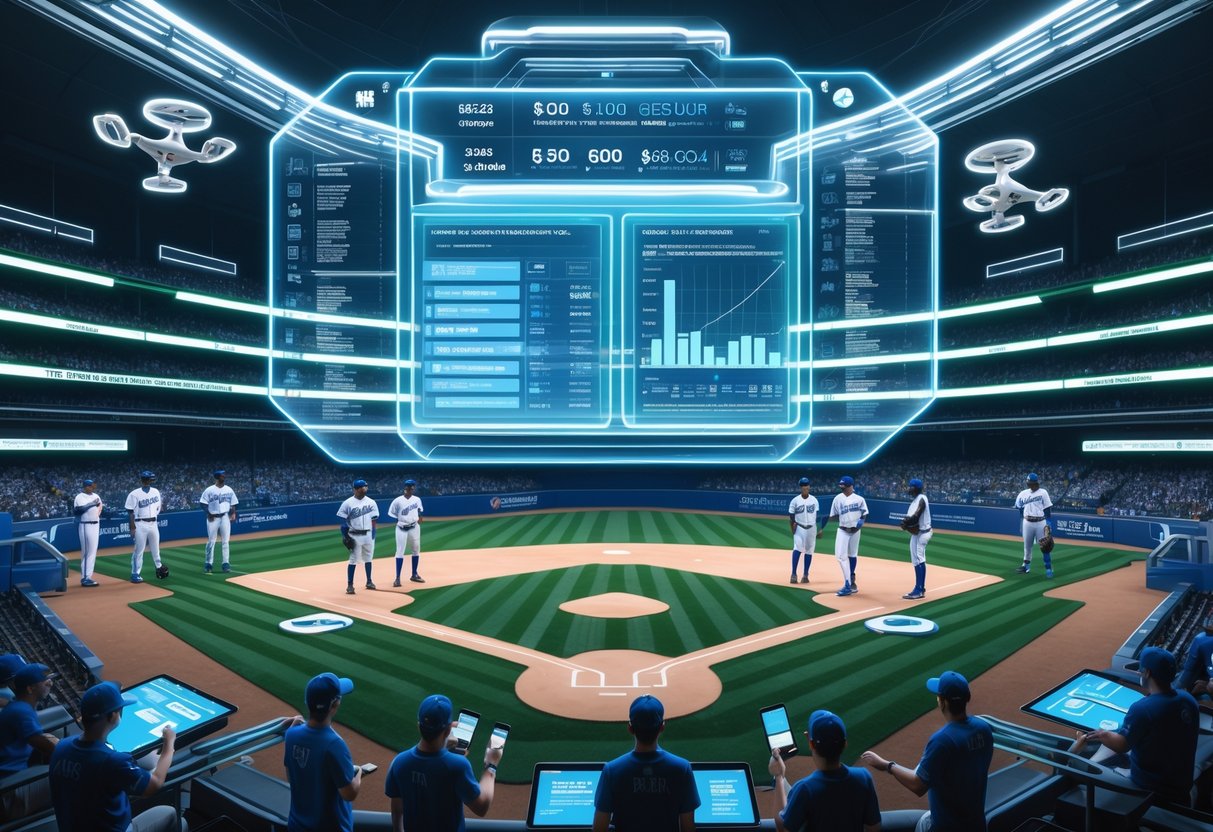Salary Cap Debates: Analysing MLB’s Controversy and Competitive Balance
Updated On: October 23, 2025 by Aaron Connolly
Understanding the Salary Cap Debate
The salary cap debate really boils down to whether teams should face limits on spending for player wages and how those choices ripple through competitive balance. Baseball doesn’t use a hard salary cap—just a luxury tax—so it faces some issues you don’t see in other sports.
Key Terms and Concepts
A salary cap is just a ceiling on what teams can spend on player salaries each year. That hard limit keeps richer teams from simply buying up all the best players forever.
Most salary caps are “hard caps.” Teams can’t go over them, period. If they try, the league hits them with harsh penalties—think lost draft picks or even sanctions.
A luxury tax system is softer. Teams can spend past a threshold, but they pay hefty fines for doing so. MLB goes with this approach instead of a hard cap.
Competitive balance is the idea that teams should be pretty evenly matched. Without spending limits, rich teams often scoop up the top talent and run away with things.
Revenue sharing means teams with more money send some of it to smaller clubs. The idea is to level things out without actually capping what teams can spend.
In baseball, the payroll disparity can be wild—sometimes over £150 million separates the top and bottom spenders. That gap gives deep-pocketed clubs a clear leg up.
Salary Caps Versus Luxury Tax Systems
Hard salary caps lock teams into strict spending limits. The NFL uses this to keep things fair across the board.
Teams have to make tough calls to stay under the cap. Sometimes that means cutting popular players or letting stars walk.
Luxury tax systems let teams go over the line, but at a price. MLB taxes clubs that spend more than about £170 million on payroll.
Wealthy teams often just shrug and pay the tax. For them, it’s the price of staying stacked with talent.
The luxury tax works like a “soft cap.” Some teams steer clear of the threshold to avoid extra costs and keep their options open.
Revenue sharing pairs with the luxury tax in baseball. The league takes penalty money and hands it to smaller teams, hoping it helps balance things out.
But let’s be honest—this doesn’t close the spending gap like hard caps do in other sports.
How MLB Differs from Other Sports Leagues
Football leagues like the NFL have nailed down hard salary caps. Every team gets the same spending limit, so money can’t buy championships.
That setup means clever coaching and smart roster moves matter more than just having the biggest wallet.
Basketball has a cap, too, but it’s a bit more flexible. The NBA lets teams go over in certain cases but still keeps a lid on wild spending.
Baseball does its own thing. MLB stands alone among major sports by skipping hard caps. The players’ union hates the idea, arguing it would kill player earnings.
MLB’s luxury tax threshold sits around £170 million. Teams can blow past it, but repeat offenders get hit with stiffer penalties.
| League | System Type | Spending Limit | Penalty for Exceeding |
|---|---|---|---|
| NFL | Hard Cap | £150-180m | Cannot exceed |
| NBA | Soft Cap | £95-110m | Luxury tax |
| MLB | Luxury Tax | £170m | Escalating penalties |
Contract structures are another story. Baseball deals are fully guaranteed, while football contracts usually have performance clauses and can be cut short pretty easily.
The Financial Landscape of Major League Baseball
Major League Baseball skips the salary cap, which means some teams spend over £300 million while others scrape by with under £50 million. That huge gap mostly comes from uneven revenue streams and lopsided TV deals that favor big-city teams.
Revenue Streams and Distribution
MLB teams pull in cash from several sources. Ticket sales, concessions, and merchandise make up the basics, but these numbers swing wildly depending on the city.
Broadcasting rights are the real moneymaker for most clubs. Teams cut their own local TV deals, and the difference between markets is massive.
Corporate sponsorships and naming rights add even more. Teams like the Yankees can charge a fortune for these, while smaller markets can’t come close.
MLB’s revenue sharing system does send some money from the rich to the poor teams, but it only covers about 30% of league revenue.
The luxury tax acts like a “soft cap,” punishing teams that spend too much. Penalties can hit 20-50% of the overspent amount, but big-market teams often just eat the cost.
Impact of Broadcasting Rights and Local TV Deals
Local TV contracts are where things get really lopsided in MLB. The Dodgers’ deal with SportsNet LA is worth about £6 billion over 25 years.
Big-market teams cash in:
- New York Yankees: Over £40 million a year from YES Network
- Boston Red Sox: £60+ million from NESN
- Tampa Bay Rays: Less than £15 million from their TV deal
These TV deals let rich teams pay for stars, while small-market clubs have to rely on developing young players and making smart trades.
Streaming services are starting to shake things up. Apple TV+ and others now broadcast some games, which could bring in new money for everyone—eventually.
Still, the gap keeps growing. Big markets keep upping their deals, while smaller ones struggle to keep pace.
Current Payroll Disparities and Competitive Imbalance
The gulf between MLB’s richest and poorest teams has never been wider. The Dodgers spend close to $400 million, while Miami barely cracks $47 million. That kind of gap gives rich teams a huge edge and leaves smaller markets scrambling for creative solutions.
Big Market Versus Small Market Teams
Team payrolls have exploded over the last ten years. In 2012, MLB spent £2.5 billion total. Now, it’s up to £3.7 billion.
Here’s the kicker—rich teams spend way more, but poor teams are actually spending less.
| Year | Highest Payroll | Lowest Payroll | Gap |
|---|---|---|---|
| 2012 | £175m (Yankees) | £43m (Astros) | £132m |
| 2025 | £310m (Dodgers) | £37m (Marlins) | £273m |
Small market teams just can’t keep up. They don’t have the same ticket sales, TV money, or sponsorships as big-city clubs.
Owners in smaller cities call it unfair, and honestly, who can blame them? On the flip side, big-market owners say they’re just playing by the rules.
The competitive imbalance shows up in the playoffs. Since 2017, central division teams rarely make it to the World Series.
Case Study: Los Angeles Dodgers and New York Yankees
The Los Angeles Dodgers have set a new high bar for spending. In 2025, their competitive balance tax payroll hits £310 million.
This past offseason, they handed out over £315 million in new contracts—think Blake Snell, Roki Sasaki, and Tanner Scott.
The Dodgers get clever with deferred money. Shohei Ohtani’s £550 million deal defers £535 million, so they only pay him £2 million a year for now. That leaves room for even more stars.
Even the New York Yankees can’t quite keep up. Owner Hal Steinbrenner said it’s “difficult for most of us owners to do the kind of things they’re doing.”
That’s wild, considering the Yankees used to be the gold standard for spending.
Both teams rake in cash from huge TV contracts and corporate deals. Small-market teams just can’t match that.
Case Study: Tampa Bay Rays and Small Market Success
The Tampa Bay Rays show you don’t need a huge budget to win—at least for a while. They’ve made the playoffs regularly, spending just £60-80 million a year.
Tampa Bay leans hard on player development and analytics. They draft well, grow their own talent, and trade players before they get too expensive.
But it’s a tightrope walk. One bad draft or a blown trade can set them back years.
Other small-market winners include Oakland in the early 2000s and Kansas City in 2014-2015. Still, those stories are rare.
The Rays’ way works, but there’s a ceiling. They can’t hang onto stars forever and have to keep rebuilding.
Honestly, pulling off small-market success takes a near-perfect front office and a bit of luck.
The Role of the Luxury Tax System
The luxury tax system gives teams a way around hard caps, letting them go over spending limits if they pay financial penalties. This setup forces clubs to think hard about payroll management and moves some money to help balance things out.
Luxury Tax Threshold and Penalties
The luxury tax threshold marks the line above which teams start paying fines. Go over it, and the penalties climb fast.
In the NBA, the luxury tax started in 2001-2002 as a simple $1-for-$1 penalty. Now, the rates get steeper the more you overspend.
Here’s how the penalties usually look:
- First-timers: $1.50 for every extra dollar
- Repeat offenders: $2.50-$4.25 per dollar
- Even higher rates if you really blow past the limit
The luxury tax line tends to sit 15-20% above the regular cap. If the cap is £100 million, the tax might kick in at £115-120 million.
Teams that go way over can end up owing £100+ million just in tax.
Effects on Team Spending Strategies
The luxury tax changes how teams think about building their rosters. Rich teams can still outspend everyone, but it costs them.
Clubs take different approaches based on their budgets. Some avoid the tax at all costs; others pay up when they’re chasing a title.
Typical strategies:
- Tax avoidance: Stay just under the threshold
- Strategic overspending: Pay the tax during a championship run
- Roster cycling: Alternate between high and low spending years
Veteran players on mid-level deals often get squeezed out. Teams prefer cheap rookies who don’t push them into tax territory.
The luxury tax sits between a free-for-all and a strict cap. It lets teams spend, but not without consequences.
Revenue Sharing: Intended Balance or Broken Model?

Revenue sharing was supposed to make things fair, but MLB’s setup leaves a lot to be desired. Small-market clubs still have a tough time, even though the system moves hundreds of millions of pounds every year.
Mechanics of MLB Revenue Sharing
MLB’s revenue sharing redistributes around £600 million each year from richer clubs to poorer ones. Teams put about 48% of their local revenue into a central pot.
That money gets split evenly among all 30 teams. It covers local TV deals, ticket sales, and sponsorships.
Main revenue streams:
- Local TV contracts
- Stadium ad money
- Naming rights
- Premium seating
But here’s the catch—some money isn’t shared. Teams keep merchandise profits, concession sales, and certain stadium revenues.
Big-market teams like the Yankees and Dodgers still pull in way more cash from these unshared streams.
Recent numbers show the top spenders still outpace the bottom by more than £200 million a year. That gap sticks around, even after revenue sharing.
Challenges for Small Market Clubs
Small market teams keep running into competitive disadvantages, even with revenue sharing in place. The Pittsburgh Pirates, for example, pulled in around £20 million from shared revenue but only spent about £90 million total on player salaries in 2024.
Meanwhile, the Los Angeles Dodgers handed out a whopping £250 million in payroll. Revenue sharing just hasn’t bridged that huge spending gap.
Small market teams deal with:
- Limited local broadcast revenue
- Smaller fan bases
- Fewer corporate sponsors
- Lower ticket prices
Owners in these markets sometimes keep the shared revenue instead of putting it back into their rosters. No one forces them to use that money for player salaries.
The Tampa Bay Rays somehow put together competitive teams on shoestring budgets. Still, most small market clubs can’t pull off the same magic with analytics and player development.
Without salary floors or rules forcing teams to spend, revenue sharing turns into more of a profit boost than a tool for real competitive balance.
Arguments For and Against a Salary Cap in MLB

The salary cap debate in MLB always seems to circle back to three big questions: Would spending limits make competition fairer? Would they shrink player paychecks? And would they tie players’ hands when it comes to picking teams? Each side digs in, and you can feel the tension between owners, players, and fans.
Claims of Competitive Balance
People who want a salary cap say it would level the field between rich and poor clubs. Right now, payroll gaps sometimes stretch over £150 million from top to bottom.
Teams like the Yankees and Dodgers keep outspending everyone else. Year after year, they scoop up the best free agents.
The numbers are hard to ignore:
- Big market teams dominate playoff spots
- Same franchises keep fighting for championships
- Small market teams can’t hang on to their stars
Cap supporters think a level spending field would force everyone to get creative. Clubs would actually have to develop players and make smart decisions, not just open their wallets.
Fans in smaller markets might finally have real hope. Right now, if you root for the Oakland Athletics, you know your team just can’t keep up with the coastal giants.
Fears of Salary Suppression
The MLB Players Association pushes back hard against any talk of a salary cap. They worry it would cut player salaries across the board.
Without a cap, stars can cash in with massive contracts as teams fight for their signatures. Deep-pocketed clubs set the market for elite players.
Players worry about:
- Losing leverage in free agency
- Seeing their market value capped
- Missing out on big earnings during short careers
Players also point out that baseball contracts are guaranteed. Even if a player gets hurt, he still gets paid.
Union leaders argue that owners rake in bigger revenues but want to clamp down on player pay. They see salary caps as a way for owners to pad profits while holding down salaries.
Plenty of players remember the labor fights over these same issues. The 1994-1995 strike? Salary cap proposals from owners helped spark that mess.
Effect on Player Autonomy
A salary cap could really change how players pick their teams. Right now, top free agents can sign wherever the money’s right.
With a cap, players might have fewer ways to maximize their earnings. If every team faces the same spending limit, competition for stars could shrink.
Players worry about:
- Fewer choices when picking teams
- Trouble reuniting with old teammates
- Less chance to play in favorite cities
Some guys just want to play for a certain organization or city. A cap could block that if teams don’t have room under the limit.
Right now, players can reward teams that invest in winning—better facilities, coaching, support staff. Bigger offers help lure top talent.
But, honestly, the current system mostly gives real choice to the superstars. Role players often have limited options, cap or no cap.
The Players’ Union and Collective Bargaining Dynamics

The MLB Players Association stands firmly against salary cap proposals. They see them as threats to player earnings and career freedom. These battles play out in collective bargaining agreements, and the current deal runs out in December 2026. Expect fireworks when talks heat up.
Players’ Union Position and History
The MLB Players Association has shot down salary caps every time they come up in bargaining, going all the way back to the 1994-1995 strike. Union leader Tony Clark recently said a cap “is not necessary” for baseball.
Union leaders argue:
- Salary caps shrink what players can earn
- The luxury tax already keeps spending in check
- Players deserve a fair cut of rising revenues
- Caps don’t actually fix competitive balance
The union represents everyone on 40-man rosters across all 30 teams. Over the years, they’ve won big benefits for players, like free agency and minimum salary hikes.
Union officials make regular rounds during spring training. This year, they’re holding special lunches to teach players about bargaining and get them ready for the next round.
Collective Bargaining Agreement Negotiations
The current agreement wraps up on 1st December 2026. Both sides are already gearing up for a possible showdown.
Commissioner Rob Manfred has started visiting clubhouses to talk changes—including salary caps—with players. Phillies star Bryce Harper reportedly told Manfred to “get the f— out of our clubhouse” during one of these visits.
Negotiation battles include:
- Expansion leverage: The league might dangle new teams (and 132 new jobs) to get players to accept a cap
- Legal lines: Talking caps outside formal bargaining could break labor laws
- Strike risk: Union leaders openly expect a possible work stoppage if owners push a hard cap
The union could even hit Manfred with Unfair Labour Practice charges for trying to sidestep union leaders and pitch ideas straight to players.
Owner Perspectives and Economic Considerations

Baseball owners juggle a mess of financial worries when it comes to salary caps. They’re caught between spending wars and the challenge of keeping long-term revenue stable in markets of all sizes.
Team Owners’ Interests
Big-market teams like the Dodgers and Yankees love the current freedom to spend. The Dodgers’ £280 million payroll in 2025 shows how top clubs can flex their financial muscle.
These owners claim that big spending sparks fan excitement and boosts TV money. They worry a cap would clip their wings and shrink league revenues.
Small-market owners face a different struggle. Teams in places like Baltimore or Kansas City can’t keep up with big spenders year after year.
Baltimore Orioles owner David Rubenstein has said he wishes baseball had a cap. Many other small-market owners agree but dread the long lockout it might take to get there.
Rob Manfred wants to shake up how TV money and revenue sharing work. A cap could help smooth over some of those tough talks among owners.
Financial Risks and Spending Floors
The luxury tax doesn’t really stop teams from spending. Clubs blow past those thresholds when chasing a title or a superstar like Juan Soto.
Payroll gaps put pressure on all owners. If one team spends big, fans want their team to match it. That arms race gets pricey, and small markets can’t keep pace.
A salary cap would probably come with a salary floor too. That would force low-spending teams to meet a minimum payroll, which protects players while capping the top.
Steve Greenberg from Allen and Company thinks baseball franchise values lag behind the NFL and NBA because MLB has no spending controls. That hurts owners’ long-term investments.
But any lockout needed to force a cap could cost millions and sour fans in every market.
Influence on Free Agency and Offseason Activity

Salary cap arguments really shake up how teams chase players and build rosters in the offseason. Teams with no spending limits keep dominating free agency, while those with caps need to get clever just to stay competitive.
Impact of Lack of Cap on Free Agency
Sports without salary caps create a totally different free agency scene. MLB probably shows this better than anyone.
Spending Disparities The Dodgers and teams like them can just throw out huge contracts. Small-market clubs can’t even get close. That splits the league into haves and have-nots.
No cap means stars go wherever the biggest check is. We’ve seen this play out over and over.
Market Distortion Effects Without limits, free agency turns into a spending contest instead of a chess match. Even mid-level players cash in when rich teams start bidding wars.
The union has always fought against caps. Still, some analysts think the system is so lopsided now that a cap could actually help even things out.
Concentration of Talent Teams with deep pockets hoard talent in ways capped leagues simply don’t allow. The same handful of spenders stay at the top, year after year.
When just a few teams can outspend everyone else combined, competitive balance takes a back seat.
Offseason Strategies of High and Low Payroll Teams
Teams shape their offseason moves around their budgets and any cap rules that might exist.
High Payroll Team Tactics Rich teams go after proven veterans in free agency. They can gamble on pricey deals because luxury tax penalties barely slow them down.
These clubs often sign short, high-value contracts to stay flexible while adding instant impact.
Low Payroll Team Approaches Teams on tight budgets focus on player development and bargain signings. They look for undervalued guys or players coming off injuries.
Many lean on analytics to find players who are better than their stats (or price tag) suggest. That means investing in sharp scouting and data teams.
Creative Cap Management Teams near the cap have to get crafty:
- Trading away big contracts to clear space
- Using exceptions like mid-level or bird rights
- Short-term deals for future flexibility
- Developing young talent on cheap rookie contracts
Honestly, the best organizations mix and match these tactics, no matter how much they spend.
Player Development and Team Building in an Uncapped System

With no salary caps, teams can pour money into player development and build rosters with a long view, not just the next payroll deadline. That opens the door for deeper talent pipelines and smarter roster building focused on potential, not just price tags.
Developing Talent on a Budget
Teams in uncapped leagues often find that player development is the best bang for their buck. Instead of chasing pricey veterans, smart clubs invest in academies and coaching infrastructure.
Some franchises put 15-20% of payroll into development. That covers coaching, analysts, and training facilities—basically, everything needed to turn raw prospects into solid contributors.
Patience pays off here. Teams can let players grow for two or three years without sweating over cap space. Over time, that usually beats shelling out for established vets.
The best programs focus on:
- Individual skill work
- Mental training
- Fitting into team systems
- Physical conditioning
Quick win: Teams that invest early in development often see results in 18 months—better performance and less need to overpay for outside help.
Long-Term Roster Construction
No cap means teams can plan rosters around timelines, not just money. That freedom lets them balance winning now with building for the future.
Smart clubs often split the roster into three groups: core veterans (30-40% of payroll), up-and-coming talent (25-30%), and role players (the rest). This setup brings stability and room to grow.
Without a cap, teams can keep their stars through their best years. Instead of losing talent to budget cuts, organizations can focus on building a winning culture that keeps players around.
Long-term roster strategies:
- Staggering contracts to keep continuity
- Investing in consistent coaching
- Building depth, not just chasing stars
- Creating healthy competition for spots
Heads up: Even without limits, teams still need to spend wisely. Unlimited spending isn’t a shortcut to success—and it can backfire if the books get out of control.
Fan Engagement and the Public Perspective

Baseball fans these days talk a lot about salary cap issues. Recent polls say over two-thirds want spending limits.
People get frustrated by the imbalance and rising costs. It just makes the sport feel less accessible and less fun to watch.
Viewpoints on Competitive Balance
Strong Public Support for Change
Fans keep voicing their frustration with the current system. Polls show most baseball supporters want salary caps.
A lot of them argue that unlimited spending makes seasons boringly predictable. Teams with big budgets sign up the stars, and smaller clubs just can’t keep up.
The Competitive Imbalance Problem
Supporters see how financial gaps hurt their teams’ chances. When payrolls differ by over £150 million, hope kind of fades away.
This turns the league into a two-tier system. Fans of rich teams expect wins, while others just accept mediocrity.
The lack of surprise takes some excitement out of the sport.
Impact on Match-Day Experience
- Smaller market stadiums see fewer fans.
- Struggling teams sell less merchandise.
- TV viewership drops in non-competitive regions.
- Fans lose loyalty when teams can’t keep up financially.
Growing Demand for Financial Reform
Commissioner Acknowledges Concerns
MLB Commissioner Rob Manfred has started talking about the pressure from fans over salary caps. He says he gets loads of emails after big spending sprees by wealthy teams.
That sort of public statement shows fan engagement has reached the top levels of the sport.
Rising Costs Affecting Accessibility
Fans have to pay more for tickets, snacks, and even team gear. When teams overspend on players, those costs often get passed on.
Families find it tougher to afford games. Working-class fans, who used to be the backbone of baseball, feel squeezed out.
Social Media Amplification
Fans use social platforms to organize and push for salary caps. Online petitions and group messages keep the pressure on league officials.
Fan engagement isn’t just in the stands anymore. Supporters are loud online, demanding fairness and more balance in the game.
The Future of Salary Cap Debates in Baseball

Baseball’s at a big turning point as the current collective bargaining agreement ends in December 2026. League officials want both salary caps and floors, but the players’ union is still pushing back hard against spending limits.
Potential Reforms and Emerging Trends
MLB is looking at big changes to its financial system before 2027. Rob Manfred and the owners have kicked around the idea of both caps and floors.
This setup would look different from other sports. A salary floor would make low-spending teams like the Orioles and Rays pay more for players.
A salary cap would stop teams like the Mets and Dodgers from outspending everyone else.
Right now, the luxury tax system just isn’t cutting it. Some teams blow past $300 million in payroll, while others spend way less.
Fans in smaller markets notice, and they’re not happy.
Key proposed changes include:
- Teams would have to meet minimum spending.
- There’d be a ceiling on payrolls across the league.
- Revenue sharing might get a facelift.
- Contract rules could change.
Nobody’s really sure about the timeline. Manfred says real negotiations are still “two years away,” so we probably won’t see concrete proposals until late 2025 or early 2026.
What Lies Ahead for MLB’s Economic System
The road ahead looks rough. Both sides are stubborn.
The Major League Baseball Players Association has always fought salary caps. They see them as a threat to player earnings.
A lockout could hit in December 2026. Owners and players are far apart, and a work stoppage is a real risk.
In the past, labor fights have hurt baseball’s popularity and pushed fans away.
Contract negotiations would look totally different with a cap. Those massive deals—like Juan Soto’s 15-year, $765 million contract or Shohei Ohtani’s $700 million payday—might disappear.
We might see more team-friendly deals, like Jackson Merrill’s nine-year, $135 million extension with San Diego.
Players could start signing early just to lock in some security before free agency.
The financial debate isn’t just about caps and floors. Revenue sharing, international signings, and minor league pay will all come up.
These talks are going to shape baseball’s money game for the next decade.
Frequently Asked Questions

The salary cap debate in Major League Baseball brings up tough questions about fairness, player rights, competitive balance, and the financial impact. Here are some of the most common concerns about what a salary cap could mean for the sport.
What are the arguments for and against implementing a salary cap in Major League Baseball?
Supporters say a salary cap would level the playing field. Fans worry teams like the Dodgers and Yankees have too much of an edge.
A cap would make teams spend similar amounts on players. That could make the season more exciting since anyone might win.
Opponents focus on player freedom. Right now, players can get paid what they’re worth. Some contracts go over £200 million because teams fight for top talent.
Baseball has its own traditions, too. Unlike other sports, MLB has never had a salary cap. Some people think that’s part of its charm.
Revenue sharing and luxury taxes already try to keep things balanced. Some folks argue those are enough.
How might a salary cap impact competitive balance amongst MLB teams?
A salary cap would probably make teams more equal when it comes to spending. Rich teams wouldn’t just buy all the best players.
Smaller-market teams would get a better shot. They wouldn’t have to face clubs with payrolls three times bigger.
But smart team management would matter more than ever. Teams with good coaching and player development could still come out on top.
A salary floor would push low-spending teams to invest more. The mix of caps and floors could really shake up the balance.
Some people worry the overall talent level could drop. If top players can’t earn big, maybe fewer athletes pick baseball over other sports.
What are MLB players’ views on the introduction of a salary cap?
Players mostly don’t like salary caps. Caps limit how much they can make.
The current system lets stars negotiate for what they’re really worth. Many players feel salary caps are just a way for owners to keep more profits while holding down wages.
The players’ union has always fought hard against salary caps. They’d rather stick with the luxury tax.
Players also worry caps would lower earnings for everyone, not just the stars. Even average players benefit when teams spend freely.
Some might support caps if there were strong salary floors. That would mean every team has to spend a certain amount.
How have salary caps affected other major sports leagues, and what lessons could MLB learn from them?
The NFL’s hard salary cap leads to tight competition. Most teams can build similar rosters, so seasons are less predictable.
The NBA’s system is a bit more flexible. Teams can go over the cap to keep their own players, but there’s still an overall limit.
Both leagues show salary caps can work. Balance has improved since they started.
But those sports set up caps early on. Baseball would have a harder time changing its old system.
Revenue sharing makes a big difference, too. Leagues that split TV money and other income see better balance between rich and poor teams.
What are the potential financial ramifications for MLB teams if a salary cap is introduced?
Rich teams would have to cut spending fast. They might trade expensive players or let contracts run out.
Low-spending teams would actually spend more. A salary floor would force them to invest in better rosters.
Ticket prices could shift. Smaller teams might raise prices if they get more competitive. Big-market teams might have to lower prices if team quality drops.
Team values could change a lot. Wealthy franchises might lose their edge, while smaller ones could gain.
Player contracts would look different. Long-term deals could be risky for teams near the cap.
Teams might put more money into facilities, tech, and fan experience instead of just player salaries.
Can you explain the history of salary cap debates and player strikes within baseball?
People in baseball have argued about salary caps for decades. The topic always seems to pop up when players and owners sit down to negotiate.
Back in 1981 and again in 1994-95, salary cap disputes sparked major strikes. Players flat-out refused to accept caps, so games—and even entire seasons—got wiped out.
The 1994 strike hit especially hard. That year, they cancelled the World Series, and honestly, a lot of fans just checked out after that.
These days, MLB has steered away from hard caps. Instead, the league uses luxury taxes, so teams pay penalties if they spend too much.
Negotiations lately? They’re still a battleground. Owners keep pushing for tighter spending, but players don’t want more restrictions.
Right now, the system sort of walks a line. Teams can spend big if they want, but those financial penalties are there to keep things in check.


